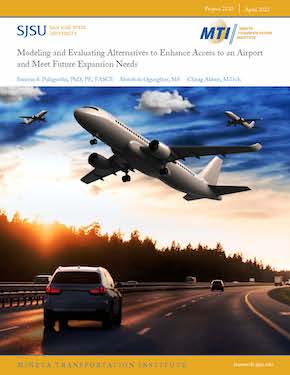- 408-924-7560
- mineta-institute@sjsu.edu
- Donate
Modeling and Evaluating Alternatives to Enhance Access to an Airport and Meet Future Expansion Needs
The continued growth of air travel calls for the incessant construction effort at many airports and their surroundings. Thus, there is a need to determine how airports can better manage existing infrastructure to accommodate this growth. This study, therefore, focuses on (1) investigating how changes in transportation infrastructure have affected travel time reliability (TTR) of the surrounding road network within the airport vicinity over time, and, (2) exploring selected unconventional intersection designs and proposing new inbound/outbound access routes from the nearby major roads to the airport. The efficiency of road networks that surrounds large airports is discussed using Charlotte Douglas International Airport (CLT) as the case study. Firstly, an assessment of how transportation projects impact link-level travel time reliability (TTR) was performed using historical data. Secondly, an assessment of how future transportation projects would affect the traffic in the airport vicinity was performed. A simulation network was developed using the Vissim software, where the peak-hour turning movement counts were used with the existing signal design to replicate and calibrate the base scenario. Unconventional intersection designs such as continuous flow intersections (CFI), mini-roundabouts, and restricted crossing U-turn (RCUT) intersections were considered along with selected bridge design options to determine the impact on TTR. The results were compared with the conventional signalized intersection design. The connectivity projects led to an increase in TTR measures at most of the links within its vicinity after the project’s completion of the project. Similarly, parking areas exhibited the same characteristics, including those used by ridesharing companies. The simulation model showed that unconventional designs like RCUT and direct entry-exit ramps effectively reduced delay as well as the number of stops, increasing our understanding of how expansion projects affect TTR and potentially improving infrastructure optimization.
SRINIVAS S PULUGURTHA, PHD, PE, FASCE
Dr. Pulugurtha is currently working as a Professor & Research Director of the Department of Civil and Environmental Engineering at the University of North Carolina at Charlotte. He is also the Director of the Infrastructure, Design, Environment, and Sustainability (IDEAS) Center at the University of North Carolina at Charlotte.
ABIMBOLA OGUNGBIRE, MS
Mr. Ogungbire is pursuing his PhD in the Infrastructure and Environmental Systems (INES) program at the University of North Carolina at Charlotte. His areas of interest are traffic data analytics and visualization.
CHIRAG AKBARI, MTECH
Mr. Akbari is pursuing his PhD in Civil Engineering at the University of North Carolina at Charlotte. His areas of interest are traffic operations, simulation modeling, and the application of unconventional designs.
-
Contact Us
San José State University One Washington Square, San Jose, CA 95192 Phone: 408-924-7560 Email: mineta-institute@sjsu.edu






